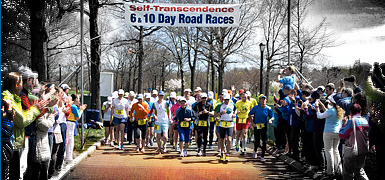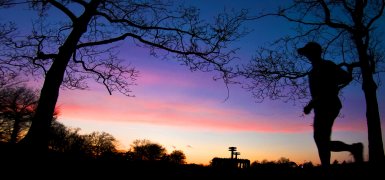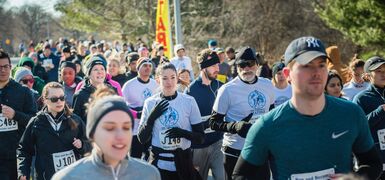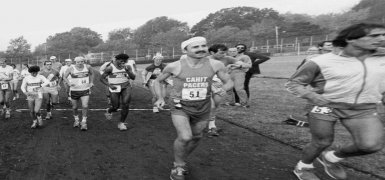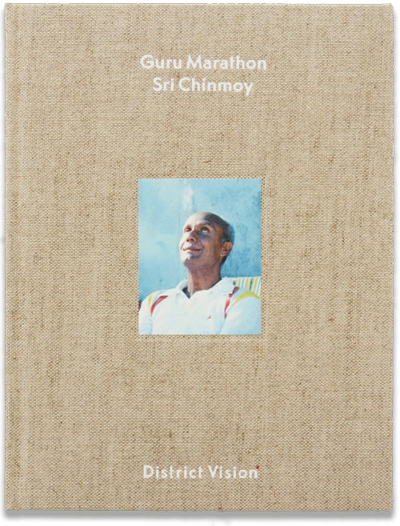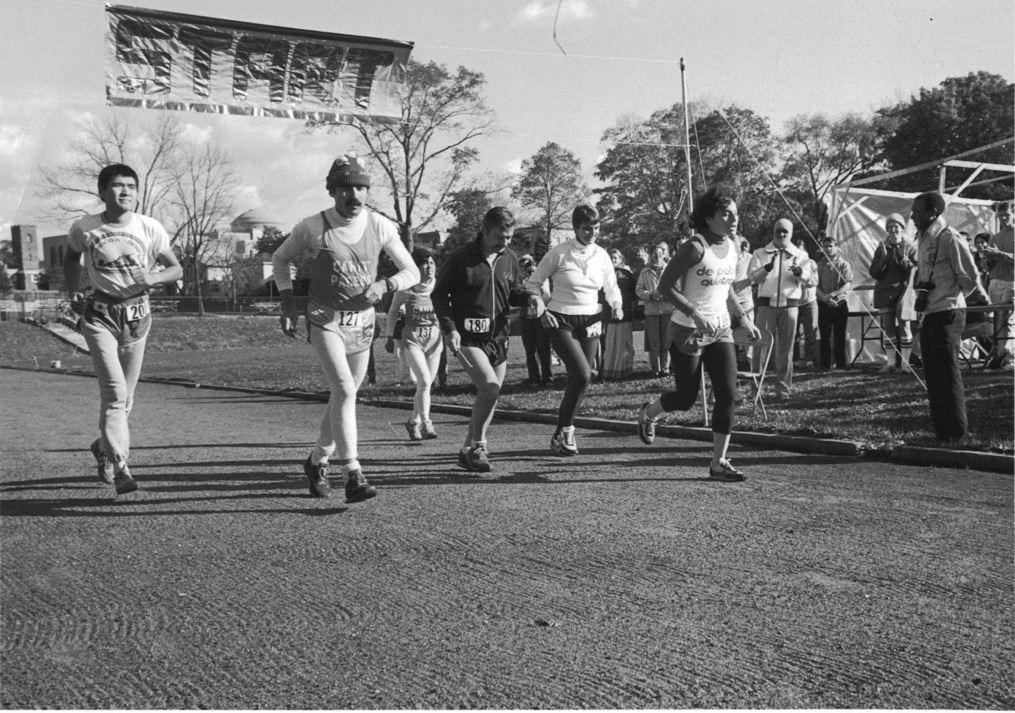 Our first 24-Hour event was held in 1980 on a cinder track in Greenwich, CT, an affluent hamlet outside the boundaries of New York City, and a world apart from our home and enclave in Queens, NY. It was perhaps a twist of fate that this event became reality. A 24-hour race to be held on the East coast of the US was cancelled. Some local runners of whom the Marathon Team had befriended were sad that had happened. Sri Chinmoy got word of this situation and suggested we offer a 24-Hour race to fill the hole left by cancellation. I remember three of us officials heading to Greenwich, CT a day or two later after the decision was made. A disciple whose local business was willing to sponsor the event, procured permission from Greenwich City Hall to clean and rake the grounds behind it and make measurement of the inner ring around the track. It was measured just slightly less than a standard 440-yard track at that time (before tracks were designed at 400 meters, the current worldwide standard). The Athletics Congress (TAC) and our friend Ted Corbitt approved of the work, and distance splits were recorded and marked. Official marks were to be given at 50 miles,100 km, 100 miles and of course, total distance. We found out later the track had a name - the Havenmeyer Track. (Photo above: the 6 runners at the start of the first 24-Hour Race sponsored by the Sri Chinmoy Marathon Team. Far right, Ted Corbitt. Third from right Sri Chinmoy.)
Our first 24-Hour event was held in 1980 on a cinder track in Greenwich, CT, an affluent hamlet outside the boundaries of New York City, and a world apart from our home and enclave in Queens, NY. It was perhaps a twist of fate that this event became reality. A 24-hour race to be held on the East coast of the US was cancelled. Some local runners of whom the Marathon Team had befriended were sad that had happened. Sri Chinmoy got word of this situation and suggested we offer a 24-Hour race to fill the hole left by cancellation. I remember three of us officials heading to Greenwich, CT a day or two later after the decision was made. A disciple whose local business was willing to sponsor the event, procured permission from Greenwich City Hall to clean and rake the grounds behind it and make measurement of the inner ring around the track. It was measured just slightly less than a standard 440-yard track at that time (before tracks were designed at 400 meters, the current worldwide standard). The Athletics Congress (TAC) and our friend Ted Corbitt approved of the work, and distance splits were recorded and marked. Official marks were to be given at 50 miles,100 km, 100 miles and of course, total distance. We found out later the track had a name - the Havenmeyer Track. (Photo above: the 6 runners at the start of the first 24-Hour Race sponsored by the Sri Chinmoy Marathon Team. Far right, Ted Corbitt. Third from right Sri Chinmoy.)
The athletes were informed of the opportunity, and five stalwarts promised participation. We looked to add one more male participant just to even the ranks of gender.
With the preparation of the track and the construction of a few tents for counting, food, and medical supervision, we welcomed the runners to the track on November 1, 1980. The most heralded runner was Marcy Schwam, 27, from Queens, who had dazzled ultras on the east and west coasts, and was hoping for a fast 100 miles. She had reached 113 miles in 24 hours running in a 24 hour in 1979, but her record had been broken by Sue Ellen Trapp, who reached 123 miles, 596 yards. Her training partner Jackie Stack, 30, had been a consistent runner who was looking for new abilities at longer distances. She was rumored to be the niece of famous fitness figure Walt Stack, who caught the fancy of sports enthusiasts in the San Francisco area with his daily exploits of swimming, biking and running, bare-chested, near Golden Gate Bridge and Park- at age 50+.
The third female was Sharon Yeter, a member of Cahits Pacers, a Bronx, NY running club led by the irrepressible Cahit Yeter, her husband, a Turkish ex-pat turned Bronx bus driver who was a very good local runner and former 2:13 marathoner. Wes Emmons, 52, from Pennsylvania, was the senior runner of the group who was willing to push himself to new distances in a long fitness career. The third male was 19 year-old Yasu Shimisu, a courier, working inter-agency for the UN, who had never run more than 14 miles at a time!
Sri Chinmoy, in his traditional style, meditated with the athletes and assembled helpers just before the start at 9:00am on a crisp, fall morning. This was our first ultra-marathon for the public, and the Marathon Team was hoping to meet the challenge just as much as the athletes. Six runners answered the command from American Olympian and the fabled ‘Father of Ultrarunning,’ Ted Corbitt, to begin.
Marcy Schwam left no doubt of her fitness level by ripping through the 50 mile split in 6:43:23, a new world female track best, reducing the previous best by mere seconds (6:44:43 by Judy Ikenbery in 1977). Cahit Yeter was behind her by over 20 minutes, marveling at her speed and determination. At the 100 km split, Marcy passed a second world best in 8:46:35, nearly an hour faster than any mark known at that time.
Undaunted, she moved towards the female all-time 100-mile mark, set by American Natalie Cullimore in 1971, at 16:11:01. Marcy, ignoring intestinal issues and stiffening legs, reached deep down to pass the world best with a sterling run in 15:44:27. Her World, American, and course records would last for a few years until a new generation of female runners who graduated from the marathon moved up to ultras to test their abilities.
But there were still over eight hours left in the race, and the irony and agony of this ordeal had not fully played out. Marcy rested and grabbed some downtime in a tent while helpers massaged tired, cramping legs. With the primary inspiration-engine off the track, the other runners’ efforts became less constant. Except for one competitor. Young, inexperienced Yasu Shimizu had jogged past his first marathon in 4:40, and somehow reached 100 km in 11:28:43. At 3:00am on the track, he was the only one still moving, trying to unlock every bit of energy from his thin, shocked frame and muscles. Perhaps his meditation practices or his genetic disposition as a suspected samurai helped his forward movement. He reached 100 miles in 21:21:22, running confidently if not competently. Marcy emerged from her tent again with three hours to go and dragged her body along, hoping to hold off the young Japanese stalwart. Alas, in an epic effort, Yasu Shimizu held on for the overall win with 111miles 1462yds.
Marcy, three records in her pocket, reached 111 miles, happy, exhausted, but surely amused and bewildered by the 24-hour time frame. She was about 12 miles away from the womens’ 24-hour record. I think it was proven in this race that the 24-hour event separates itself from a competitive 100 mile in so many ways. They appear to be two separate kinds of events. Running through the night is a puzzle that must be solved by the athlete. Even more remarkable is the determination by the athlete to face difficult barriers, and to cross them, without undue damage, injury or harm to their psyche. Having optimal conditions and dedicated support from friends and the race helpers contributed immensely.
After returning to New York from the race after the clean-up, I met up with fellow helpers and shared a common thread- it was much more inspiring helping out at ultras than our shorter events. The inner satisfaction we received, while not even running a step, was worth all the planning, helping and working for hours and hours. It was not adulation that we were seeking, it was something deeper. I am sure Sri Chinmoy was delighted by the outcome. In the months and years that followed, we began to muse - ‘what might be next?’
Sri Chinmoy 24-Hour Race November 1-2, 1980 Greenwich,CT cinder track
1 Yasumasa Shimizu, 19, Tokyo Japan 111 mi 1462yd Overall winner, first ultra (11:28:43 100km, 21:21:22 100 miles)
2 Marcy Schwam, 27, Jamaica,NY 111 mi WWR,NR,CR: 50 mi-6:43:23, 100km 8:46:35, 100 miles 15:44:27
3 Jackie Stack, 30, Queens,NY 80 mi 1320yd (100km 11:20:38 )
4 Sharon Yeter, 38, Bronx,NY 78 mi 577yd (100km 13:16:19)
5 Wes Emmons, 52, PA 70 mi 1702yd (12:37:52 )
6 Cahit Yeter, 45, Bronx,NY 62 mi 241yd (100km 9:35:20)
Marcy Schwam recalls the ordeal of this 24-hour adventure:
Quotes taken from an article by ultra-marathon historian Nick Marshall, himself a respected ultra-runner for over four decades. His words are in italics.
(Marcy) “At 75 miles I had to make a decision about whether to concentrate on the 24 hours or throw what I had left into getting a good 100-mile time. I was in a great position to break 16 hours. Even feeling so bad, I thought I could last to 100 miles OK. It felt like it was going to be rough past there no matter what I did, so I just concentrated on breaking the 100-mile record.
Then it happened. As soon as I reached 100 miles I stopped. Immediately. In a split second- instant, instant pain…The pain ended it right there. The 24-hour record was out…I tried walking with blankets around me, just trying to move around the track, but it was nothing I could control.”
(Nick Marshall) The remaining eight hours to the official end of the race were an uncomfortable blur of resting, sleeping, and stumbling around the track, always cold, always cold. When the full 24 hours had expired, Schwam had a total distance of 111 miles.
Six months later Marcy tried a six-day event.
(Nick Marshall) Marcy Schwam….. became the first woman in the 20th century to try a six-day raceThe Edward Payson Weston Six Day in Pennsauken,NJ was strictly a modern athletic endurance contest. All 13 starters had at least 100-miler under their belt. Twelve of them were men...Hampered by a sore tendon the last two days, and facing a hot summer sun every day, Schwam nonetheless logged a total of 384 miles by the expiration of the sixth day. Park Barner’s winning total was 430 miles but the second-place man wound up more than 40 miles behind Schwam
Indeed, Marcy Schwam was a tough, dedicated runner who pushed herself through 140-mile training weeks, testing herself and setting a great example to female runners invested in the marathon to try longer races.

